External links
63°48′38.5″N138°38′54.7″W / 63.810694°N 138.648528°W / 63.810694; -138.648528
| | This article about a Yukon location is a stub. You can help Wikipedia by expanding it. |
Paris was a small community in the Klondike region of Yukon, Canada on Dominion Creek during the Klondike Gold Rush (1898). Postal contract documents showed that it still existed in 1911, but all traces have disappeared today. It owed its name to its large proportion of French speakers and the fact that its postmaster was born in Paris, France.
63°48′38.5″N138°38′54.7″W / 63.810694°N 138.648528°W
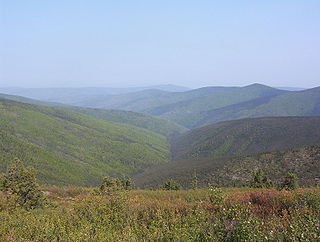
The Klondike is a region of the territory of Yukon, in northwestern Canada. It lies around the Klondike River, a small river that enters the Yukon River from the east at Dawson City. The area is merely an informal geographic region, and has no function to the territory as any kind of administrative region. It is located in the traditional territory of the Tr’ondëk Hwëch’in First Nation.

Yukon is the smallest and westernmost of Canada's three territories. It is the third-least populated province or territory in Canada, with a population of 45,148 as of 2023. However, Whitehorse, the territorial capital, is the largest settlement in any of the three territories.

Dawson City, officially the City of Dawson, is a city in the Canadian territory of Yukon. It is inseparably linked to the Klondike Gold Rush (1896–1899). Its population was 1,577 as of the 2021 census, making it the second-largest city in Yukon.
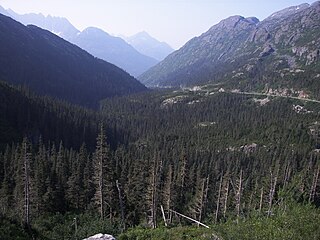
White Pass, also known as the Dead Horse Trail, is a mountain pass through the Boundary Ranges of the Coast Mountains on the border of the U.S. state of Alaska and the province of British Columbia, Canada. It leads from Skagway, Alaska, to the chain of lakes at the headwaters of the Yukon River.
Moosehide was an Indian reserve of the Tr'ondëk Hwëch'in First Nation or Dawson band in the Canadian territory of Yukon between about 1906 and the early 1960s. Located near a tradiitonal salmon-fishing ground, Moosehide was first occupied about 9,000 years ago. Starting the mid-1800s, and accelerating the Klondike Gold Rush, European settles arrived in the area and began to settle in and around Dawson City. The Tr'ondëk Hwëch'in were forced to relocate, first just to the south of Dawson and in 1897 to Moosehide. The St. Barnabas Church was built by the Anglican Church of Canada in 1908. A cemetery with about 200 burials is located behind the church. Moosehide is also the site of the cabin of Chief Isaac, who was the leader of the Tr'ondëk Hwëch'in during the Klondike Gold Rush. At the time of the 1911 census, 'Moose Hide' was a village, with a recorded population of 125.

The Trʼondëk Hwëchʼin is a First Nation band government located in the Canadian territory, Yukon. Its main population centre is Dawson City, Yukon.
Pelly Crossing is a community in Yukon, Canada. It lies where the Klondike Highway crosses the Pelly River.
Klondike is a neighborhood in eastern Louisville, Kentucky, United States. Due to being on the edge of the old city limits, its boundaries are irregular, it is south of Hikes Lane and west of Breckenridge Lane. Development began after World War II, with developers Edward Butler and Chester Cooper purchasing and subdividing 45 acres (180,000 m2) of the Graff farm and part of the Hikes family's Midlane farm.
Canyon City is a Klondike Gold Rush ghost town and a Yukon Government Heritage Site. It is located about 7 km from downtown Whitehorse, Yukon at the upstream end of Miles Canyon on the Yukon River. Summer tours are encouraged.

Forty Mile is best known as the oldest town in Canada’s Yukon. It was established in 1886 at the confluence of the Yukon and Fortymile rivers by prospectors and fortune hunters in search of gold. Largely abandoned during the nearby Klondike Gold Rush, the town site continued to be used by Tr’ondëk Hwëch’in. It is currently a historic site that is co-owned and co-managed by Tr'ondëk Hwëch'in and the Government of Yukon. Ch’ëdähdëk became part of the Tr’ondëk-Klondike UNESCO World Heritage Site in 2023, recording of the transformation of the landscape and the Indigenous adaptation to European colonization.

CKRW-FM is a hot adult contemporary radio station in Whitehorse, Yukon, Canada.
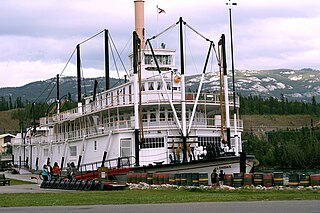
SS Klondike is the name of two sternwheelers, the second now a National Historic Site located in Whitehorse, Yukon. They ran freight between Whitehorse and Dawson City, along the Yukon River, the first from 1929 to 1936 and the second, an almost exact replica of the first, from 1937 to 1950.

Stewart Crossing is a settlement in Yukon, Canada located on the Stewart River. It is about 179 km east of Dawson City on the Klondike Highway, near the junction with the Silver Trail, from which it is about 53 km (33 mi) southwest of Mayo. A Yukon government highway maintenance camp and a highway lodge are the most prominent facilities at Stewart Crossing. The settlement is named for where the Klondike Highway, crossed the Stewart River by means of a ferry from 1950 until completion of a bridge in the mid-1950s.
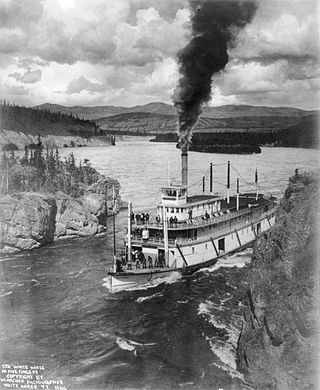
Steamboats on the Yukon River played a role in the development of Alaska and Yukon. Access to the interior of Alaska and Yukon was hindered by large mountains and distance, but the wide Yukon River provided a feasible route. The first steamers on the lower Yukon River were work boats for the Collins Overland Telegraph in 1866 or 1867, with a small steamer called Wilder. The mouth of the Yukon River is far to the west at St. Michael and a journey from Seattle or San Francisco covered some 4,000 miles (6,400 km).
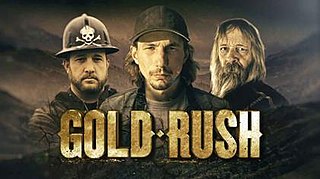
Gold Rush is a reality television series that airs on Discovery and its affiliates worldwide. The series follows the placer gold mining efforts of various family-run mining companies, mostly in the Klondike region of Dawson City, Yukon, Canada, as well as in the U.S. state of Alaska. In its 12th season as of early 2021, prior seasons also included mining efforts in South America and western North America.

Sergeant Preston of the Yukon is a half-hour long American action adventure northwestern television series, broadcast in color on CBS Thursday evenings at 7:30 to 8:00 p.m. from September 29, 1955, to September 25, 1958. It was based on the radio drama Challenge of the Yukon.

Sixtymile River is a tributary of the Yukon River, which heads in the U.S. state of Alaska before crossing into Yukon, Canada.

Grand Forks is a ghost town and former community at the confluence of Bonanza Creek and Eldorado Creek in the Canadian territory of Yukon. First settled about 1896, it became the second-largest settlement in the Klondike. With approximately 10,000 people living in or by Grand Forks during the Klondike Gold Rush, it was the only community besides Dawson City to have a municipal government. The Grand Forks Hotel was a roadhouse here during the gold rush.

Discovery Claim is a mining claim at Bonanza Creek, a watercourse in the Yukon, Canada. It is the site where, in the afternoon of August 16, 1896, the first piece of gold was found in the Yukon by prospectors. The site is considered to be the place where the Klondike gold rush started. It is located around 17 kilometres (11 mi) south-southeast of Dawson City. The Discovery claim was designated a National Historic Site of Canada on July 13, 1998.

Dredge No. 4 is a wooden-hulled bucketline sluice dredge that mined placer gold on the Yukon River from 1913 until 1959. It is now located along Bonanza Creek Road 13 kilometres (8.1 mi) south of the Klondike Highway near Dawson City, Yukon, where it is preserved as one of the National Historic Sites of Canada. It is the largest wooden-hulled dredge in North America.